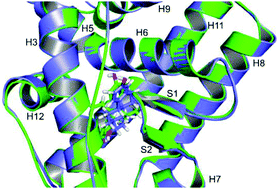Computational biochemical investigation of the binding energy interactions between an estrogen receptor and its agonists†
Abstract
In this work we describe the profiles of the estrogen receptor ERα, the most common type of hormone receptor on breast cells, in terms of its total binding energy in the presence of its full agonist ligands, endogenous 17β-estradiol and synthetic diethylstilbestrol, which are responsible for a large percentage of all breast cancers. The X-ray crystallographic structures of ERα in complexes with both agonists are considered, and the electrostatically embedded molecular fractionation with conjugate caps (EE-MFCC) scheme is applied within a dispersion-corrected density functional theory (DFT-D) framework, taking into account the B97D/cc-pVTZ level of theory. Our quantum chemical computational results show that the total binding energy of both agonists to the ERα ligand-pocket, with radius varying from 2.0 to 12.5 Å, is well correlated with the experimental agonist binding affinity. In addition, we found that the most significant contributions to the total binding energy of the receptor–endogenous (synthetic) ligand complexes are mainly due to 12 (14) amino acid residues. Finally, we predict the energetic relevance of the estradiol and diethylstilbestrol regions, as well as the influence of each protein segment on ERα–agonist binding. This information is important for helping to decide whether or not the cancer is likely to respond to either endocrine therapy or other clinical treatments.



 Please wait while we load your content...
Please wait while we load your content...